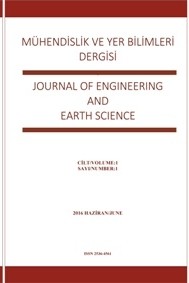Manisa Yakın Bölgesinin Sismik Tehlike Kaynakları ve Manisa için Sismik Risk Durumlarının Değerlendirilmesi
Manisa il merkezi yakın civarının sismik risk değerlendirmelerinde, konumları il merkezine 100 km mesafeden daha uzakta olan depremlerin il merkezi üzerinde ihmal edilebilir etkilere sahip olduğu kabul edilmiştir. Bundan dolayı, analizlerde 6 sismik alt-bölge dikkate alınmıştır. Dikkate alınan alt-bölgeler farklı sismotektonik karakteristiklere sahip olup, konumları il merkezine yakın mesafelerde (≤100 km) yer almaktadır. Gutenberg – Richter magnitüd – frekans ilişkisi, sismik risk tahminleri ve tekerrür periyotları her alt bölge için ayrı ayrı belirlenmiştir. Aletsel (1900 – 2015) dönemin (mw≥4.0) ve 1900 yılından önceki tarihsel (I0 ≥5.0) dönemin her ikisine ait datalar analizlerde kullanılmıştır. Analizlerde, a ve b magnitüd – frekans ilişki katsayıları sırasıyla 3.36 ±0.13 – 4.90 ±0.41 ve 0.45 ±0.02 – 0.68 ±0.07 aralıklarında belirlenmiştir. Alt bölgeler için, sismik kaynak – saha mesafe olasılık dağılımları hesaplanmıştır. Kaynak – saha mesafe olasılık dağılımları, 2, 4 ve 5 alt-bölgeleri içinde meydana gelecek depremlerin, 1, 3 ve 6 alt-bölgeleri içinde meydana gelecek depremlerden, Manisa il merkezi için daha yıkıcı etkilere sahip olabileceğini işaret etmektedir.
Anahtar Kelimeler:
Kaynak – saha mesafe olasılık dağılımı, Manisa il merkezi, Poisson modeli, sismik risk, tekerrür periyodu
Seismic Hazard Sources of Manisa Nearby Region and Their Seismic Risk Evaluation for Manisa
In the seismic risk assessments for the close vicinity of Manisa city center, it is assumed that earthquakes located further away from 100 km than the city center have negligible effects on the city center. So, 6 seismic sub-regions are considered in the analysis. The considered sub-regions have different seismotectonic characteristics and they are located in the close distance (≤100 km) to the city center. Gutenberg–Richter magnitude–frequency relations, recurrence periods and seismic risks have been computed for the sub-regions, separately. The data belonging to both the instrumental period (1900-2015) (mw≥4.0) and historical period before 1900 (I0 ≥5.0) has been used in the analysis. According to the results, a and b coefficients of the magnitude – frequency relations were computed in the intervals 3.36 ±0.13 – 4.90 ±0.41 and 0.45 ±0.02 – 0.68 ±0.07, respectively. Seismic source-to-site distance probability distributions were computed for the sub-regions. Source-to-site distance probability distributions indicate that earthquakes will occur within the 2, 4 and 5 sub-regions may have more destructive effects on Manisa city center than an earthquake will occur within the 1, 3 and 6 sub-regions.
Keywords:
Manisa city center, Poisson model, recurrence period, seismic risk, source-to-site distance probability distribution,
___
- Sayıl, N. Osmanşahin, İ. (2008). An investigation of seismi-city for western Anatolia. Nat Hazards 44, 51-64.
- Algermissen, S.T., Perkins, D.M., Thenhaus, P.C., Hanson, S.L., Bender, B.L. (1982). Probabilistic estimates of maxi-mum acceleration and velocity in rock in the contiguous United States. Y.: Assesment of the seismic risk of western Anatolia by Semi-Markow model. Geophysics. Open-file report 82-1033, U.S. Geological Survay, Washington, U.S, 99s.
- Alsan, E, Tezuçan, L., & Bath, M. (1975). An earthquake cata-logue for Turkey for the interval 1913–1970. Report Kandilli Observatory, Istanbul and Uppsala Univ, Sweden.
- Altınok, Y. (1991). Assesment of the seismic risk of western Anatolia by Semi-Markow model. Geophysics, 5, 135-140.
- Ambraseys, N.N. (2001). Reassesment of earthquakes, 1900–1999, in the eastern Mediterranean and themiddle east. Ge-ophys J Intern. 145,471–485.
- ISSN: 2536-4561
- Başlangıç: 2016
- Yayıncı: Remzi BAŞARI
